
A meterstick is mounted horizontally above a turntable as shown. Identical metal washers are hung at the positions shown. The turntable and meterstick are then spun. Rank from greatest to least, the following quantities for the washers.
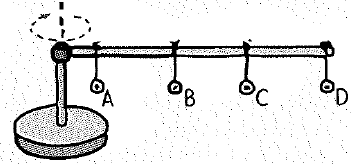
a. rotational speed
b. linear speed
c. angle the string makes with the vertical
d. inward force on each
e. outward force on each
(a)
To rank: The washer on the basis of rotational speed from greatest to least.
Answer to Problem 20A
The rank of the rotational speed from greatest to least is
Explanation of Solution
Introduction:
Rotational speed is the number of rotations per unit time and is also known as angular velocity. It is represented as
The given figure is shown below.
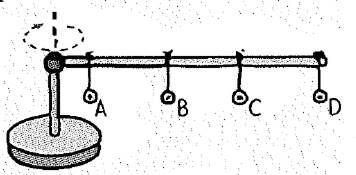
Identical metal washers are hung at the positions on a meterstick is mounted horizontally above a turntable.
The rotation of turn table rotates the metal washers in the meterstick at the same speed. Hence, the rotational speeds of the metal washers are same.
Conclusion:
Thus, the rank of the rotational speed from greatest to least is
(b)
To rank: The washer on the basis of the linear speed from greatest to least.
Answer to Problem 20A
The rank of the linear speed from greatest to least is
Explanation of Solution
Introduction:
The expression for the linear or tangential speed is,
Here,
Tangential speed is dependent on the distance from the axis of rotation and rotational speed.
The given figure is shown below.
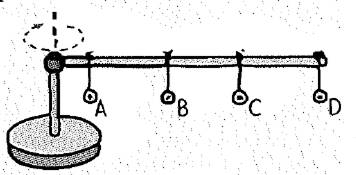
The linear speed and the radius of its circular path’ radius are directly proportional to each other.
The radius of the metal washer D is more when compared to the other washers.
The radius of the metal washer A is less when compared to the other washers.
So, the metal washer D’s linear speed is greater than the linear speed of the other washers.
Conclusion:
Thus, the rank of the linear speed from greatest to least is
(c)
To rank: The washer on the basis of angle that string makes with the vertical from greatest to least.
Answer to Problem 20A
The rank of the angle the string makes with the vertical from greatest to least is
Explanation of Solution
Introduction:
The force exerted on the system is directly proportional to the square of the tangential speed.
Linear speed varies with the distance from the axis of rotation.
The expression for the linear or tangential speed is,
Here,
The given figure is shown below.
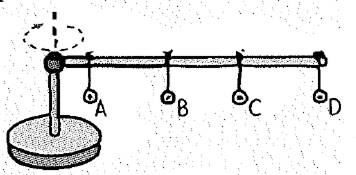
The linear speed is directly proportional to the radius of its circular path.
From part (b), the rank of the linear speed from greatest to least is
The radius of the metal washer D is more when compared to the other washers.
The radius of the metal washer A is less when compared to the other washers.
By comparing the values of the angle the string makes with the vertical is
Conclusion:
Thus, the rank of the angle the string makes with the vertical from greatest to least is
(d)
To rank: The washer on the basis of the inward force on each from greatest to least.
Answer to Problem 20A
The rank of the inward force on each from greatest to least is
Explanation of Solution
Introduction:
The expression for the centripetal force is,
Here,
The expression for the linear or tangential speed is,
Here,
The given figure is shown below.
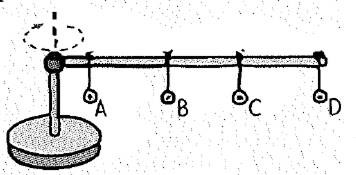 From part (b), the rank of the linear speed from greatest to least is
From part (b), the rank of the linear speed from greatest to least is
The centripetal force or inward force is directly proportional to the square of the linear speed.
By comparing the values of the linear speed, the centripetal force is
Conclusion:
Thus, the rank of the inward force on each from greatest to least is
(e)
To rank: The washers on the basis of outward force from greatest to least.
Answer to Problem 20A
The outward force is not there for the system.
Explanation of Solution
Introduction:
The expression for the centripetal force is,
Here,
The expression for the linear or tangential speed is,
Here,
The given figure is shown below.
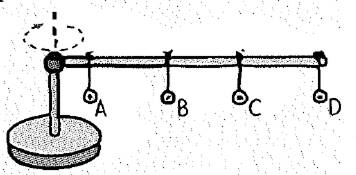
The centripetal force is the inward force and it is directly proportional to the square of the linear speed.
In the meterstick and turntable, there is only the centripetal or inward force act on the system.
So there is outward force doesn’t act on the system.
Conclusion:
Thus, outward force is not there for the system.
Chapter 10 Solutions
Conceptual Physics: The High School Physics Program
Additional Science Textbook Solutions
College Physics: A Strategic Approach (3rd Edition)
Cosmic Perspective Fundamentals
Microbiology: An Introduction
Chemistry: A Molecular Approach (4th Edition)
Campbell Essential Biology (7th Edition)
Human Anatomy & Physiology (2nd Edition)
- For items 8-9, refer to the problem below. Find all the currents flowing in every resistor, power dissipation in every resistor and the total power of the circuit shown at the right using... 8. Kirchhoff's Laws (5 pts) 9. Maxwell's Mesh Analysis (5 pts) A 8 V 10 V B + 20 Ω 3Ω 202 wwww C wwww 202 + 50 www 12 Varrow_forward• Nature of Resistance Temperature-Resistance Relationship Ohm's Law, Energy and Power Kirchhoff's Law • Maxwell's Mesh Analysis 1. A coil of copper wire (p = 10.37 2-cmil/ft) has a length of 600 ft. What is the length of an aluminum conductor (p 17 cmil/ft), if its cross-sectional area and resistance are the same as those of the copper coil? (Hint: Look for conversion of inches to mils and square inches to square foot. Include it in your solution.) (1 pt) 2. The copper field winding of an electric machine has a resistance of 46 at temperature of 22°C. What will be its resistance at 75°C? (Use do = 0.00427 /°C for copper) (1 pt) 3. The resistivity of a copper rod 50 ft long and 0.25 inch in diameter is 1.76 μ at 20°C. What is its resistance at - 20°C? (1 pt) 4. When two resistors A and B are connected in series, the total resistance is 36 2. When connected in parallel, the total resistance is 8 Q. What is the ratio of the resistance RA to resistance RB? Assume RA < RB. (1 pt) 5. The…arrow_forward2. Two equally strong individuals, wearing exactly the same shoes decide to do a tug of war. The only difference is individual A is 2.5 meters tall and individual B is 1.5 meter tall. Who is more likely to win the tug of war?arrow_forward
- 6. A car drives at steady speed around a perfectly circular track. (a) The car's acceleration is zero. (b) The net force on the car is zero. (c) Both the acceleration and net force on the car point outward. (d) Both the acceleration and net force on the car point inward. (e) If there is no friction, the acceleration is outward.arrow_forward9. A spring has a force constant of 100 N/m and an unstretched length of 0.07 m. One end is attached to a post that is free to rotate in the center of a smooth. table, as shown in the top view in the figure below. The other end is attached to a 1kg disc moving in uniform circular motion on the table, which stretches the spring by 0.03 m. Friction is negligible. What is the centripetal force on the disc? Top View (a) 0.3 N (b) 3.0 N (c) 10 N (d) 300 N (e) 1000 Narrow_forward4. A child has a ball on the end of a cord, and whirls the ball in a vertical circle. Assuming the speed of the ball is constant (an approximation), when would the tension in the cord be greatest? (a) At the top of the circle. (b) At the bottom of the circle. (c) A little after the bottom of the circle when the ball is climbing. (d) A little before the bottom of the circle when the ball is descending quickly. (e) Nowhere; the cord is pulled the same amount at all points.arrow_forward
- 3. In a rotating vertical cylinder (Rotor-ride) a rider finds herself pressed with her back to the rotating wall. Which is the correct free-body diagram for her? (a) (b) (c) (d) (e)arrow_forward8. A roller coaster rounds the bottom of a circular loop at a nearly constant speed. At this point the net force on the coaster cart is (a) zero. (b) directed upward. (c) directed downward. (d) Cannot tell without knowing the exact speed.arrow_forward5. While driving fast around a sharp right turn, you find yourself pressing against the left car door. What is happening? (a) Centrifugal force is pushing you into the door. (b) The door is exerting a rightward force on you. (c) Both of the above. (d) Neither of the above.arrow_forward
- 7. You are flung sideways when your car travels around a sharp curve because (a) you tend to continue moving in a straight line. (b) there is a centrifugal force acting on you. (c) the car exerts an outward force on you. (d) of gravity.arrow_forward1. A 50-N crate sits on a horizontal floor where the coefficient of static friction between the crate and the floor is 0.50. A 20-N force is applied to the crate acting to the right. What is the resulting static friction force acting on the crate? (a) 20 N to the right. (b) 20 N to the left. (c) 25 N to the right. (d) 25 N to the left. (e) None of the above; the crate starts to move.arrow_forward3. The problem that shall not be named. m A (a) A block of mass m = 1 kg, sits on an incline that has an angle 0. Find the coefficient of static friction by analyzing the system at imminent motion. (hint: static friction will equal the maximum value) (b) A block of mass m = 1kg made of a different material, slides down an incline that has an angle 0 = 45 degrees. If the coefficient of kinetic friction increases is μ = 0.5 what is the acceleration of the block? karrow_forward
 College PhysicsPhysicsISBN:9781305952300Author:Raymond A. Serway, Chris VuillePublisher:Cengage Learning
College PhysicsPhysicsISBN:9781305952300Author:Raymond A. Serway, Chris VuillePublisher:Cengage Learning University Physics (14th Edition)PhysicsISBN:9780133969290Author:Hugh D. Young, Roger A. FreedmanPublisher:PEARSON
University Physics (14th Edition)PhysicsISBN:9780133969290Author:Hugh D. Young, Roger A. FreedmanPublisher:PEARSON Introduction To Quantum MechanicsPhysicsISBN:9781107189638Author:Griffiths, David J., Schroeter, Darrell F.Publisher:Cambridge University Press
Introduction To Quantum MechanicsPhysicsISBN:9781107189638Author:Griffiths, David J., Schroeter, Darrell F.Publisher:Cambridge University Press Physics for Scientists and EngineersPhysicsISBN:9781337553278Author:Raymond A. Serway, John W. JewettPublisher:Cengage Learning
Physics for Scientists and EngineersPhysicsISBN:9781337553278Author:Raymond A. Serway, John W. JewettPublisher:Cengage Learning Lecture- Tutorials for Introductory AstronomyPhysicsISBN:9780321820464Author:Edward E. Prather, Tim P. Slater, Jeff P. Adams, Gina BrissendenPublisher:Addison-Wesley
Lecture- Tutorials for Introductory AstronomyPhysicsISBN:9780321820464Author:Edward E. Prather, Tim P. Slater, Jeff P. Adams, Gina BrissendenPublisher:Addison-Wesley College Physics: A Strategic Approach (4th Editio...PhysicsISBN:9780134609034Author:Randall D. Knight (Professor Emeritus), Brian Jones, Stuart FieldPublisher:PEARSON
College Physics: A Strategic Approach (4th Editio...PhysicsISBN:9780134609034Author:Randall D. Knight (Professor Emeritus), Brian Jones, Stuart FieldPublisher:PEARSON





